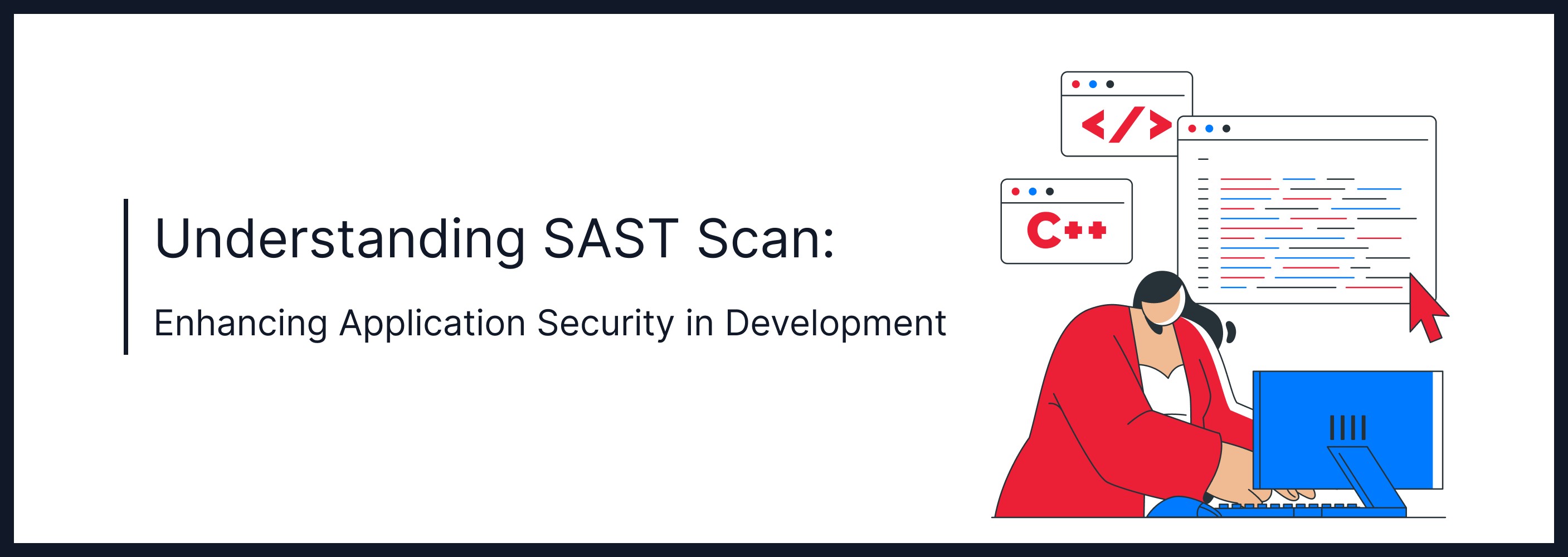
Oct 15, 2024 Information hub
Understanding SAST Scan: Enhancing Application Security in Development
In today’s fast-paced digital world, security is paramount. With the increasing reliance on software applications, the need to ensure that these applications are secure from vulnerabilities has never been more critical. One of the most effective ways to achieve this is through a SAST scan. Static Application Security Testing (SAST) is a method of analyzing source code to identify potential security vulnerabilities early in the development lifecycle.
In this blog post, we will dive deep into the concept of SAST scans, their relevance in today’s software development landscape, and how they can help organizations build more secure applications. We will also explore practical examples, current trends, challenges, and future developments in the field of SAST. By the end of this post, you will have a solid understanding of SAST scans and how they can benefit your organization.
What is a SAST Scan?
Definition of SAST
Static Application Security Testing (SAST) is a white-box testing method that analyzes an application’s source code, bytecode, or binary code without executing the program. The goal of a SAST scan is to identify security vulnerabilities such as SQL injection, cross-site scripting (XSS), buffer overflows, and other common coding flaws that could be exploited by attackers.
Unlike dynamic testing methods, which require the application to be running, SAST scans are performed early in the development process, making it easier to catch and fix vulnerabilities before they make it into production.
How Does a SAST Scan Works?
A SAST scan works by examining the codebase of an application and comparing it against a set of predefined security rules or patterns. The scan looks for coding errors, insecure coding practices, and potential vulnerabilities that could be exploited by malicious actors. Once the scan is complete, it generates a report that highlights the issues found, along with recommendations for fixing them.
The key advantage of SAST is that it allows developers to identify and fix vulnerabilities early in the software development lifecycle (SDLC), reducing the cost and effort required to address security issues later on.
Why is SAST Scan Relevant Today?
The Growing Threat of Cyberattacks
In recent years, the number of cyberattacks has skyrocketed. According to a report by Cybersecurity Ventures, cybercrime is expected to cost the world $10.5 trillion annually by 2025. As organizations increasingly rely on software applications to run their businesses, the risk of security breaches has become a top concern.
Many of these breaches are the result of vulnerabilities in the code that could have been detected and fixed during the development phase. This is where SAST scans come into play. By identifying vulnerabilities early, SAST scans help organizations reduce the risk of security breaches and protect their sensitive data.
Shift-Left Security
The concept of “shift-left security” has gained significant traction in recent years. This approach emphasizes the importance of integrating security testing early in the SDLC, rather than waiting until the application is fully developed. SAST scans are a key component of shift-left security, as they allow developers to catch security issues during the coding phase, rather than after the application has been deployed.
By shifting security testing to the left, organizations can reduce the cost and complexity of fixing vulnerabilities, improve the overall security of their applications, and accelerate the development process.
Key Benefits of SAST Scans
1. Early Detection of Vulnerabilities
One of the primary benefits of SAST scans is that they allow developers to detect vulnerabilities early in the development process. This is crucial because the cost of fixing a vulnerability increases exponentially as the application moves through the SDLC. According to a study by IBM, the cost of fixing a vulnerability in the production phase can be up to 30 times higher than fixing it during the coding phase.
By identifying vulnerabilities early, SAST scans help organizations save time and money while improving the overall security of their applications.
2. Comprehensive Coverage
SAST scans provide comprehensive coverage of an application’s codebase, including both the source code and third-party libraries. This is important because many security vulnerabilities are introduced through the use of third-party components, which may not have been thoroughly vetted for security issues.
By scanning the entire codebase, SAST scans help ensure that all potential vulnerabilities are identified and addressed.
3. Integration with CI/CD Pipelines
Modern software development practices, such as Continuous Integration and Continuous Deployment (CI/CD), require security testing to be automated and integrated into the development pipeline. SAST tools can be easily integrated into CI/CD pipelines, allowing developers to run security scans automatically as part of the build process.
This ensures that security testing is performed consistently and that vulnerabilities are identified and addressed before the application is deployed.
4. Compliance with Security Standards
Many industries are subject to strict security regulations and standards, such as the General Data Protection Regulation (GDPR), the Health Insurance Portability and Accountability Act (HIPAA), and the Payment Card Industry Data Security Standard (PCI DSS). SAST scans can help organizations comply with these regulations by identifying and addressing security vulnerabilities that could lead to non-compliance.
By ensuring that their applications meet the required security standards, organizations can avoid costly fines and reputational damage.
Practical Examples of SAST Scan in Action
SAST scan example 1: Preventing SQL Injection Attacks
SQL injection is one of the most common and dangerous security vulnerabilities. It occurs when an attacker is able to insert malicious SQL code into a query, allowing them to access or manipulate the database. A can detect SQL injection vulnerabilities by analyzing the code for insecure query construction practices, such as concatenating user input directly into SQL queries.
For example, consider the following code snippet:
String query = "SELECT * FROM users WHERE username = '" + username + "' AND password = '" + password + "'";
A SAST scan would flag this code as vulnerable to SQL injection and recommend using parameterized queries instead:
String query = "SELECT * FROM users WHERE username = ? AND password = ?";
By identifying and fixing this vulnerability early, the organization can prevent a potential SQL injection attack that could compromise their database.
SAST scan example 2: Detecting Cross-Site Scripting (XSS) Vulnerabilities
Cross-site scripting (XSS) is another common vulnerability that allows attackers to inject malicious scripts into web pages viewed by other users. A SAST scan can detect XSS vulnerabilities by analyzing the code for insecure handling of user input, such as failing to properly sanitize or escape user-provided data.
For example, consider the following code snippet:
<p>Welcome, <?php echo $_GET['username']; ?>!</p>
A SAST scan would flag this code as vulnerable to XSS and recommend sanitizing the user input before displaying it:
<p>Welcome, <?php echo htmlspecialchars($_GET['username'], ENT_QUOTES, 'UTF-8'); ?>!</p>
By addressing this vulnerability, the organization can prevent attackers from injecting malicious scripts into their web application.
Current Trends in SAST Scanning
1. AI and Machine Learning in SAST
One of the most exciting trends in SAST scanning is the integration of artificial intelligence (AI) and machine learning (ML) technologies. These technologies can help improve the accuracy of SAST scans by reducing false positives and identifying previously unknown vulnerabilities.
For example, AI-powered SAST tools can analyze large datasets of code and security vulnerabilities to identify patterns and trends that may not be immediately apparent to human developers. This can help organizations detect and fix vulnerabilities more quickly and efficiently.
2. Cloud-Based SAST Solutions
As more organizations move their development processes to the cloud, there has been a growing demand for cloud-based SAST solutions. Cloud-based SAST tools offer several advantages, including scalability, ease of integration with cloud-based CI/CD pipelines, and the ability to run scans on-demand without the need for on-premises infrastructure.
Cloud-based SAST solutions also allow organizations to take advantage of the latest security updates and improvements without having to manage and maintain their own SAST infrastructure.
3. DevSecOps and SAST
The rise of DevSecOps, which integrates security into the DevOps process, has further increased the importance of SAST scans. In a DevSecOps environment, security is treated as a shared responsibility across the entire development team, and SAST scans are used to ensure that security vulnerabilities are identified and addressed throughout the SDLC.
By incorporating SAST scans into their DevSecOps workflows, organizations can improve the security of their applications while maintaining the speed and agility of their development processes.
Challenges of SAST Scan
1. False Positives
One of the main challenges of SAST scanning is the issue of false positives. A false positive occurs when a SAST scan flags a piece of code as vulnerable, even though it is not. False positives can be time-consuming and frustrating for developers, as they may need to spend time investigating and resolving issues that are not actually security vulnerabilities.
To address this challenge, many modern SAST tools use machine learning algorithms to reduce the number of false positives and improve the accuracy of their scans.
2. Scalability
As applications grow in size and complexity, running SAST scans on large codebases can become time-consuming and resource-intensive. This can slow down the development process and make it difficult to integrate SAST scans into CI/CD pipelines.
To overcome this challenge, organizations can use cloud-based SAST solutions that offer scalable infrastructure and the ability to run scans in parallel, reducing the time required to complete a scan.
Future Developments in SAST Scan
1. Integration with Other Security Testing Tools
In the future, we can expect to see greater integration between SAST tools and other security testing tools, such as Dynamic Application Security Testing (DAST) and Interactive Application Security Testing (IAST). By combining the strengths of different testing methods, organizations can achieve more comprehensive security coverage and reduce the risk of vulnerabilities slipping through the cracks.
2. Improved Developer Experience
As the demand for SAST scans continues to grow, we can expect to see improvements in the developer experience. This may include more user-friendly interfaces, better integration with popular development environments, and enhanced reporting capabilities that make it easier for developers to understand and address security vulnerabilities.
Conclusion
In an era where cyberattacks are becoming increasingly sophisticated and frequent, ensuring the security of your applications is more important than ever. SAST scans offer a powerful and effective way to identify and fix security vulnerabilities early in the development process, helping organizations reduce the risk of breaches and protect their sensitive data.
By integrating SAST scans into your development workflow, you can improve the security of your applications, comply with industry regulations, and save time and money by addressing vulnerabilities before they make it into production.
Actionable Takeaways:
- Implement SAST scans early in the development process to catch vulnerabilities before they become costly to fix.
- Integrate SAST tools into your CI/CD pipeline to ensure continuous security testing.
- Stay up-to-date with the latest trends in SAST, such as AI-powered tools and cloud-based solutions, to improve the accuracy and efficiency of your scans.
- Educate your development team on the importance of secure coding practices and how to use SAST tools effectively.
By taking these steps, you can build more secure applications and protect your organization from the growing threat of cyberattacks.
